With the help of folk remedies for varicose veins you can stop the development of the disease for many years. They may not be considered as an alternative to medical treatment, but they may help relieve swelling and eliminate other negative effects of this disease.
Effectiveness of the folk method
Folk remedies for varicose veins help to activate the hidden forces of the body and strengthen it with the disease, but you should not consider them a panacea for the disease. Many patients of the older generation first start treating varicose veins with folk remedies and then go to the doctor. You can not do that! First of all, you should always consult a phlebologist, get recommendations for treatment from him, undergo blood tests to determine platelet levels. All folk remedies are aimed at combating the cause of the development of varicose veins, but not the consequences, so they are effective in the early stages of the disease.
Nutmeg Recipe # 1
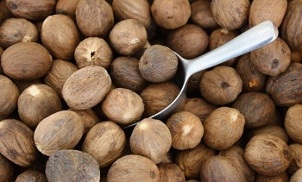
Folk remedies for varicose veins contain recipes based on nutmeg. These fruits have gained popularity because they stimulate blood circulation. However, you can not take more than one nutmeg a day. This will cause intoxication of the body and the formation of hallucinations. Nutmeg is used for varicose veins as follows:
- Whole walnuts are ground into a powder;
- Pour 1/3 teaspoon of the obtained product into 250 ml of boiling water;
- After the mixture has cooled, add a teaspoon of honey.
Take this broth before breakfast. It is advisable to prepare a new portion every day, otherwise the essential oils will disappear from the product, which will negatively affect its effectiveness. Some healers recommend making a vodka tincture using nutmeg. 200 grams of hazelnut powder is poured into 1 liter of vodka, the mixture is allowed for 1 week. Take the drug 3 times a day, 20 drops 30 minutes before eating.
Recipe # 2 based on honey and propolis
Compresses from honey are the usual way to normalize the condition of blood vessels for varicose veins. The cloth is smeared with honey on the foot. The plastic wrap is wrapped in a compress. If you are afraid that such a design could slip anywhere, then from above you can wear socks or tights. Compresses are recommended at bedtime. You can make propolis tincture according to the following recipe:
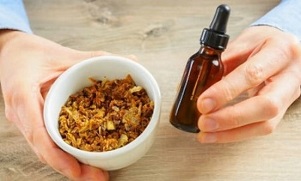
- 20 grams of propolis crushed and 30 grams of gray yolk added to it, 0. 5 lemon with cement;
- The resulting mixture is poured into 300 ml of vodka and insist for 3 weeks;
- The finished infusion is used to lubricate the legs for a month.
Apitherapy for varicose veins is indicated for those who do not suffer from allergies to bee stings. If the patient has a mild reaction to honey or propolis, this method of treating varicose veins should not be used. The procedure is performed by a doctor. It plants a certain number of bees in a biologically active place. After the bite, the bite stays in the patient's body for some time so that the venom completely penetrates the foot.
Recipe # 3 from Green Tomatoes
Unripe tomatoes are considered to be an excellent folk remedy for leg swelling with varicose veins. Doctors have theorized that unripe vegetables contain increased amounts of lycopene, so compresses of this plant perfectly relieve pain and reduce swelling of the veins. The recipe itself is quite simple. Green tomatoes are cut into large pieces and applied to the venous nodes. It is recommended to protect vegetables with a bandage. Keep compressing until a burning sensation appears. Doctors recommend performing the procedure at night.
Ginger Recipe # 4
The benefits of this plant are legendary! It is used to improve digestion, reduce weight, relieve migraines, etc. Sh. To treat varicose veins on the legs with folk remedies, you will need raw ginger root. Regular dry seasoning will not work.

One of the most popular remedies for toning the body, improving blood circulation and relieving fatigue is tea made from this spice.
Making tea is quite simple: cut the root of the plant into small pieces, pour boiling water and cook for ten to fifteen minutes. Take this remedy at a temperature comfortable for you. Ginger for varicose veins not only copes with venous bad tone, but also activates metabolism, so people who take such tea gradually lose weight. Ginger compress is also effective for varicose veins. Prepare it as follows:
- The root is very finely washed.
- The resulting onion is mixed with honey.
- Apply the mixture on inflamed veins for about three to four hours.
To increase the effect of the compresses, you can arrange the film on top, then put on warm pants or cover under a blanket. The duration of treatment is one month.
Horse Chestnut Recipe # 5
Treatment of varicose veins with folk remedies is rarely completed without the use of horse chestnut. The tincture is prepared on the basis of the fruit of the plant. The raw material is crushed before the meat grinder and then put in a three-liter jar, half filled with vodka. The mixture is infused for a month. The ratio of chestnut fruit to vodka should be one to three. Several times a week, before the mixture is infused, it is shaken and then returned to its place.
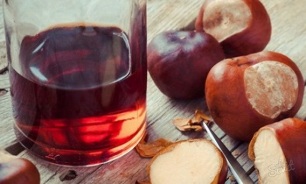
After one month, the finished tincture is used to clean the veins damaged by varicose veins. Some healers recommend using the remedy internally, but you should consult your doctor beforehand, as chestnuts themselves are poisonous and can cause bleeding as they reduce blood clotting. The infusion can be taken orally if you have an accurately increased number of platelets in your blood.
Viburnum Recipe # 6
As in the case of ginger, the berries of the plant can be used to make a fortified drink or for compresses. Viburnum compression for varicose veins is made in the standard way. The berries are ground, then the mixture is applied to a bandage or cotton cloth and then applied to the damaged area. It is necessary to maintain such a composition for 8-9 hours, so compression is recommended at bedtime. The drink is very easy to prepare. 500 ml of juice is obtained from viburnum berries, then 2 tablespoons of honey is added to the liquid. Allergy sufferers can do without the last ingredient. Drink 2 tablespoons of the drink 4 times a day.
Recipe based on # 7 mummy
This specific product is perfect for treating swelling and edema. If you are not afraid of its unpleasant odor and high price, then from the mummy you can make compresses for varicose veins. They only help well in the initial stage of the disease. Mummy is mixed with oil jelly from 1 to 5. Mix the ingredients thoroughly until smooth. Apply the ointment 3 times a day on the affected areas of the feet. Wash it 1-2 hours after use. Some recommend using a mixture of mummy, honey and milk. It is made in a ratio of 1: 6: 6. Therapy lasts 1 month.
Recipe # 8 from Adam's apple

Maclus fruit is poisonous in itself. You can not eat them like snake venom, but you can use them to create homemade ointments. You will need lard (pork fat), Adam’s apples and a glass of water bath. The container is filled with fifteen millimeters of melted bacon, and then Adam’s apple slices are placed in a ten-millimeter layer. The procedure is repeated until all the ingredients are exhausted. The last layer should be fat. After that, the container is slowly put on fire, the resulting mixture is heated, then filtered, cooled and used instead of ointment 2 times a day. Similarly, you can cook pumpkin for varicose veins.
Recipe from # 9 Lemon
Lemon treatment for varicose veins can be external and internal. Unfortunately, regular tea with these citrus fruits will not help in any way to improve the tone of the veins, but pure lemon juice is a good way to prevent further destruction of blood vessels. You can make a lemon compress. To do this, cut the citrus into circles and apply on the affected areas. You should wear such a compress throughout the day, changing circles for a new one every 3-4 hours. Of course, for a tight fixation, the leg is wrapped in bandages.
Potato Recipe # 10
This folk remedy is the most affordable as this root vegetable can be purchased at any vegetable store. Treatment of varicose veins in the legs in women using potatoes is carried out as follows:

- The root crop is washed and cleaned and then grated on a medium grinder.
- As a result, rubella spreads to the affected area.
- 8 layers of bandage or layer cut the potato and then everything is fixed with film.
compress should be held for about 4 hours. It is made from fresh potatoes. Lying potatoes are not suitable for these purposes.
Onion Recipe # 11
This is onion skin, which is effective for varicose veins and not the vegetables themselves. You can use it to strengthen your immune system, eat it raw or arrange meals with it. Onion skin can be prepared in the following way:
- Pour 500 ml of boiling water over 2 tablespoons of chopped onion. The mixture is taken for 6 hours and then filtered. Take 75 ml 3 times a day. The course of treatment is 10 days.
- 2 tablespoons chopped onion skin pour 100 ml of vodka. The mixture is infused for 7 days in a cool, dark place. The resulting tincture is taken 20 drops 3 times a day 15 minutes before meals. The course of treatment is 14 days.
Recipe # 12 based on fish oil
Varicose veins fish oil is most often taken orally. This product allows you to speed up your metabolism and eliminate fluid stagnation in your limbs.
If, for one reason or another, you do not like such a remedy, you can make a compress. To do this, mix fish oil and honey in a ratio of 1 and 1. The resulting mixture is spread on a cotton cloth or gauze, and then the affected limb with varicose veins is wrapped around it. Doctors recommend using may honey for compresses, but if you do not have it on hand, you can take any other variety.
Celery Recipe # 13
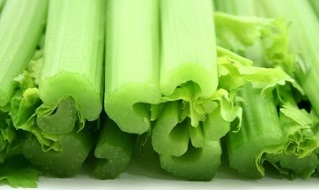
Treating leg veins with folk remedies is not always easy. Celery is contraindicated when eating with varicose veins, but it can be added to carrot juice along with spinach.
Drink a drink immediately. The ratio of carrot juice to other ingredients is 7: 3: 3.
Garlic Recipe # 14
Garlic is effective for varicose veins in the form of compresses. In this recipe, healers use the composition of this plant directly. It contains many essential oils that naturally irritate the walls of blood vessels. Prepare a garlic compress for varicose veins as follows:
- Garlic, along with the sink, crushed into a pulpy state.
- Add 1 to 2 butter to the finely chopped product.
- Mix the ingredients well.
- Apply the resulting ointment on the affected veins before going to bed and cut the bandage from the top. The duration of treatment is 1 month.
Recipe # 15 based on wormwood
Among the folk remedies for varicose veins of the leg, which contain a worm, is considered effective in the second stage of the disease. This plant promotes blood thinning, so it is effective in the second stage of the disease. The plant also stimulates digestion, improves bile flow from the liver and boosts overall metabolism. Used properly, the plant helps to destroy pathogenic microflora in the body. Worms can be used for varicose veins in a variety of ways:

- The simplest recipe is to add 3 tablespoons of chopped herbs to a 500ml jar and then fill the top with vodka. You must insist on medication for 14 days. Once the tincture is ready, it is used to lubricate the affected areas of the feet. Sour milk is obtained from the plant for compression. It is mixed with worm leaves and heads. The result should be gruel. It is used on the feet. The limbs are bandaged. It is recommended to do such a compress at night.
Rose leaf recipe # 16
Folk recipes for varicose veins often include decorations made from rose petals. Indeed, this plant has a rich vitamin composition. It contains magnesium, phosphorus, essential oils and other useful substances. But by itself, a rose with varicose veins does not force the body to regenerate. Rose tincture should be taken in small doses as this may provoke thrombosis and arrhythmias. For this reason, it is possible to treat varicose veins with this plant only after official approval by a doctor. Doctors recommend treatment with rose hips in the following cases:
- with severe mental or physical fatigue;
- exacerbates cholecystitis to facilitate bile flow;
- If the skin is severely irritated due to vitamin deficiency;
- If you have digestive problems.
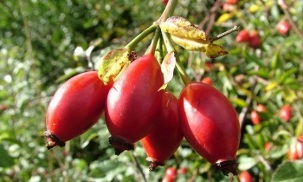
Tincture is not difficult to prepare. 15 grams of the plant is poured into 500 ml of boiling water, then wait for the broth to cool.
Do not take this remedy on an empty stomach. It can be taken only after eating. It is advisable to take about 100 ml of broth 3 times a day. When cold, you can put a rose in a raspberry. This broth activates the body's immune system.
Nettle Recipe # 17
Nettle helps to remove high platelet counts during varicose veins. Treatment can be carried out with the help of specialized decoctions, as well as other methods. Treatment of the affected area with a nettle broom is considered to be particularly effective in treating varicose veins. The movements should be from the feet to the thighs. The treated areas will itch for the first few hours, but then everything will pass. The advantage of this procedure is the activation of blood flow.
An herbal remedy for varicose veins also includes taking nettle-based decorations. Crush 2 tablespoons of dried leaves of the plant, then add to a thermos, pour 2 cups boiling water. The product should be infused within 3-4 hours. Once the infusion is ready, it is taken 1/3 of the total volume 3 times a day. When the liquid runs out, you need to cook more.
Recipe # 18 based on aloe
With the help of aloe, varicose veins can be treated only in the initial stage. The plant promotes tissue regeneration, but in itself does not require disease help. It is recommended to combine it with drug therapy. Aloe for varicose veins can be used in the following ways:
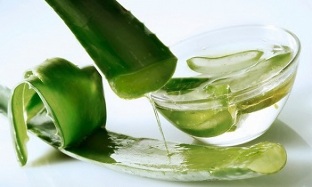
- Rub your feet with aloe juice. This will help relieve muscle spasms and reduce leg swelling.
- Mix 100 grams of aloe juice with 5 grams of mummy. Feet with oil 2 times a day for 28 days. This remedy also helps to heal small skin lesions, but it can not be used for trophic ulcers.
- Mix kalanchoe and aloe juice in equal proportions and then add 30 ml of vodka. Mix the mixture well, then apply to the feet.
- Mix aloe juice, sea buckthorn and olive oil and then mix the resulting mixture on the feet 2 times a day for 1, 5 months.
Recipe based on # 19 golden mustache
Collision is known as a universal cure for various diseases. The effectiveness of the plant in the treatment of various diseases is very easy to explain. It has a rich composition. The use of golden mustache for varicose veins in combination with other herbs has a stronger effect than the use of a single herb. To improve blood circulation it is recommended to use the following folk remedies for varicose veins:
- Mix 3-4 cups of finely chopped golden mustache with 2 cups of honey;
- Add the juice of 6 lemons and 5 crushed garlic to the mixture; The
- components are well mixed, covered in a glass jar and simmered for 7 days.
The resulting mixture is taken in 2 teaspoons 2 times a month. This composition will help to eliminate complications of varicose veins and reduce acute swelling.
Lilac Recipe # 20

Lilac tincture for varicose veins is made from the leaves according to the standard scheme, ie they fill a 500 ml half-jar with them, and then add vodka there. The mixture is taken for a week, and then the limbs are covered with the received medication. It is permissible to use the flowers of this plant instead of the leaves. Traditional healers recommend the use of lilac bark in the fight against venous nodules. It is applied to the affected area and fixed with a bandage on top. You should wear such a compress throughout the day.
Recipe based on flax seeds # 21
Use flax seeds for varicose veins in case of severe swelling. This product will help you get rid of excess fluid. Folk healers recommend using flax seed decoction once every 2 hours. Prepare it as follows:
- Put 500 ml of water on the fire and bring to a boil;
- Add 4 tablespoons of flax seeds;
- Boil the mixture for 15 minutes, then cool and filter if necessary.
Take the resulting broth should be 4 tablespoons every 2 hours until the swelling is reduced. Be sure to read the contraindications to using the product before using it. They are on the seed pack.
Mud Recipe # 22
Doctors are vague about treating varicose veins with mud. Some experts say that these procedures improve blood circulation, help the body get rid of toxins, while others argue that they can cause harm.

Treatment of varicose vein mud should be cold. At home, peloid therapy is administered through body wraps. You will need:
- wooden bowl and spoon (metal cannot be used);
- food film;
- dirt (available at a pharmacy or beauty store);
- Various additives.
In some cases, mud may be added to the mud. These components work well together. The mixture is diluted with water at room temperature until sour cream is obtained and then applied to the affected areas with varicose veins. This composition is stored on the skin for 1-2 hours. If you are dry or tight, rinse off dirt, check your body for allergies and apply a moisturizer.
Recipe from # 23 carrots
Carrot tops for varicose veins have been used for 30 years. The upper part of the plant can be obtained from any resident of the summer. Before preparing the tincture from this part of the vegetables it is necessary to rub the leaves with boiling water. This manipulation will release the plant with a bitter taste. A remedy for varicose veins can be prepared according to one of the following recipes:
For- broth, mix 10 tablespoons of finely chopped peas in 2 liters of water. The resulting mixture is heated on low heat, filtered and then taken in 20 ml 3 times a day. The duration of treatment is 14 days.
- One tablespoon of dry raw material is poured into 500 ml of boiled water, leave for 1 hour and then consume 100 ml 3 times a day.
- A more concentrated infusion is prepared in a thermos. Pour 1 tablespoon of herbs into a glass of boiling water and then simmer for 30 minutes. Drink everything after the infusion has cooled. Take 5 servings of this product daily.
Clay Recipe # 24

This fine-grained precipitate is used in various cosmetic procedures. It is best used for the treatment of vascular diseases, blue clay. It penetrates perfectly into the skin barriers and contains many useful micronutrients. The most popular clay recipe is the following:
- 200-300 grams of dry raw material diluted with water to a thick sour cream consistency;
- The resulting mixture is placed in the areas where there are swollen veins (layer thickness - 2 cm);
- A clay towel is placed on top of the leather;
- Optionally, you can fix the app with a movie.
Keep the product on your feet for at least 2 hours. Folk healers recommend it every day. The duration of treatment is 1, 5 months. After the feet have healed, the thick clay mixture can be replaced with a terry towel soaked in the clay solution.
Remember, clay is not suitable for everyone. If you have sensitive skin, replace the blue clay with red or pink if it is dry or irritated. If a rash appears, the product should be discarded.
Recipe # 25 from Hydrogen Peroxide
This folk remedy is considered slightly dangerous to health and especially to the pancreas, so it is necessary to consult a doctor. Hydrogen peroxide from varicose veins is used in two ways. The first is to take the drug orally. 1 drop of peroxide is diluted in 3 tablespoons of water and taken 2 hours after eating. Every day, the concentration of the substance increases by 1 drop, which is 10 drops. After that, rest for 72 hours and start taking 10 drops every 2 days. There is a break of 3 days between doses.
The second method is more invasive. The patient prepares a 0. 015% solution of hydrogen peroxide and then drops it intravenously. If you do not have experience with such manipulations, it is better not to do it. This input of hydrogen promotes the release of atomic oxygen. The walls of the blood vessels are cleansed, so the swelling disappears. The maximum administered dose at one time is 250 ml.
Duration and rules of treatment with folk remedies
One of the main factors influencing the effectiveness of alternative treatment is the stage of the disease. By slightly stretching the blood vessels, they will promote swelling, improve skin condition and restore venous tone. Knowing what is afraid of varicose veins, you can prevent its further development, but after the disappearance of the symptoms of the disease should not stop treatment completely. You will have to repeat the procedures with the folk remedies that came to you every 3-4 months to prevent recurrence. Treatment rules:
- Mix the ingredients in the recipes in the recommended ratio. In case of burning, itching, or other unexplained reactions, discontinue use of the product.
- Use the finished medicine for the entire recommended period of treatment and not until the first improvement.
- Store in a cool place to prevent premature deterioration.
Combination with traditional methods of treatment
It is possible to introduce traditional medicine in drug therapy only with the permission of a phlebologist. Remember that at least 2 hours should pass before using the tinctures and various tablets. When using folk remedies, you should be aware that they can not replace medications, although some healers argue that this is not the case. In addition, some homemade drugs can be life-threatening, so treatment with such methods must be carried out very carefully.
Possible risks and contraindications
Folk remedies are not a panacea. They themselves can cause allergies and other adverse reactions from the body. The use of traditional medicine is contraindicated in the following diseases:
- diseases of the stomach and intestines;
- blood clotting problems;
- Liver and kidney diseases;
- Advanced stage of varicose veins accompanied by venous thrombosis.
Patients are obliged to discuss any treatment with their doctor. It is not recommended to prescribe traditional medicine independently for you, without examining the body.




































